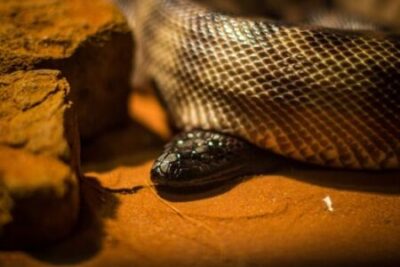Despite their beautiful colors and patterns, there are many lethal snakes in the world that can kill you with just one venomous (poisonous) bite. These snakes are always found in the warmer, tropical parts of the world.
The Inland Taipan is the most venomous snake in the world. The venom contained in just one bite is lethal enough to kill over 200 people.
Many snakes possess deadly venom, but most prefer to use this scarce resource sparingly. We’ll walk you through the most poisonous snakes on earth. We’ll then let you know which snakes cause the most human deaths.
10 Most Lethal Snakes in The World
Before we get started, how do we define the “deadliest” or “most dangerous” snakes?
You may think this is quite obvious: the snakes that can kill you most easily. However, there are many ways to interpret this question.
You may consider “deadliest” to mean “snakes with the most lethal venom.” However, the snakes with the most lethal venom are not the 10 snakes responsible for the most human casualties. This is for the following reasons:
- They do not inject as much venom when they bite. So, although a snake may have very potent venom, its bite may not be as dangerous as another venom-injecting snake.
- They rarely bite, or often “dry bite” (bite without injecting venom).
- They are reclusive and shy away from humans, not aggressive.
To start with, we’re going to look at the snakes that, with one bite, have the venom potency to kill the most humans. We’ll then look at the types of venomous snakes that are responsible for the most human deaths.
Inland Taipan
The inland taipan is the most venomous snake on earth, with the venom toxicity to kill over 200 people with one bite.
It lives in Australia, and can only be found in the arid outback on the border of Queensland and South Australia. According to the University of California’s Toxicology department, one bite from this snake could kill a human in 30 minutes. Left untreated, its bite is fatal 80%+ of the time.
The venom of the inland taipan quickly destroys every organ system in the body, including the brain. Victims of the inland taipan’s bite often suffocate to death due to paralysis of the lungs.
Fortunately, if antivenin is administered quickly, there’s a good chance that the victim will survive.
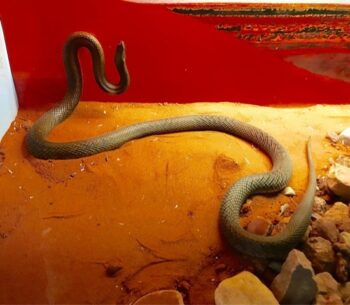
What Does the Inland Taipan Look Like?
The inland taipan is part of the family Elapidae. It has smooth and glossy scales, round pupils and a narrow, oval-shaped head. These snakes reach 6 feet in length, although some have been known to grow up to 8 feet long.
Interestingly, the inland taipan has color-changing abilities. In the summer, its scales are olive green. In the winter, they darken to a rich, deep brown. This is thought to help the snake absorb more warmth in the winter months. Its head is always slightly darker than its body.
Is the Inland Taipan Aggressive?
The inland taipan is very reclusive. Its Outback habitat is rarely frequented by humans, and if it ever comes across one, this snake is far more likely to retreat than to bite you.
It has a calm personality, and will only bite if threatened. Once it does bite, there are no second chances. “Dry” (venom-free) bites are rare, and it tends to strike multiple times in quick succession.
Forest Cobra
The Forest Cobra is native to central and western Africa, and is found in forests and savannas. One bite from a forest cobra could kill over 60 people.
The venom of the forest cobra is neurotoxic. This means that it kills nerve tissue found in the brain and the spinal cord. Associated symptoms include drowsiness, lack of muscle coordination, hearing loss, seizures, and paralysis. Death can occur between 30 minutes and 2 hours after a bite.
Fortunately, like the inland taipan, bites from the forest cobra are rare, and an effective antivenin is available.
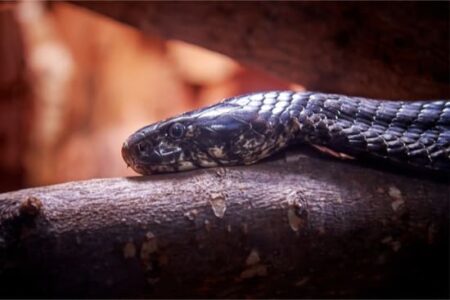
What Does the Forest Cobra Look Like?
The forest cobra is the largest “true cobra” (belonging to the genus Naja). It reaches lengths of up to 9 feet, although 7 feet is average. Like all Cobras, the forest cobra can expand its ribs to form a menacing “hood” around its head and neck. However, it will only display this when threatened.
Though there are slight color variations between forest cobras found in different regions, most forest cobras are a glossy dark brown to black. Their bellies are cream to yellow, with broad, black, horizontal bands. Some forest cobras are also speckled.
Is the Forest Cobra Aggressive?
The forest cobra is a very active and fast-moving snake but tends to avoid people when possible. They are said to be aggressive when cornered and will display their defensive hoods as a warning. If continually provoked, they will bite. They can strike quickly, and from far away.
Eastern Brown Snake
Third place for the deadliest snake in the world goes to another Australian specimen: the eastern brown snake. This snake is found all along the eastern coast of Australia, including in populated habitats.
A bite from the eastern brown snake could take down 58 humans. Its venom is more toxic than the forest cobra’s – however, the eastern brown snake delivers far less venom per bite.
Like the forest cobra, the venom of the eastern brown snake is full of neurotoxins, which causes convulsions and paralysis. However, its venom also carries blood coagulants, which cause the blood to clot. Death follows inevitably after a bite unless antivenin is administered swiftly.
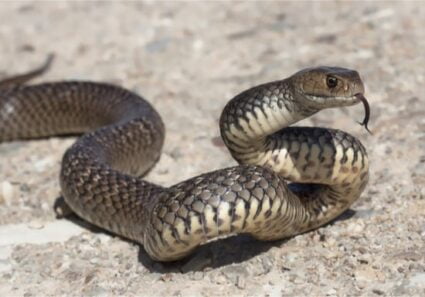
What Does the Eastern Brown Snake Look Like?
The eastern brown snake’s main identifying feature is its coloration. It is an even, pale to dark brown from head to tail, with no markings or patterning.
Its chin and underbelly are a cream color. It is a quite slender snake; its head and neck are an even width, and it has a rounded snout. When confronted, the eastern brown snake will rear itself up off the ground and flatten out its neck, to mimic a cobra.
Is the Eastern Brown Snake Aggressive?
Eastern brown snakes aren’t aggressive, but they aren’t as placid or human-fearing as inland taipans.
A study by Wildlife Research of over 400 interactions with eastern brown snakes found that, most of the time, the snake will try to retreat or hide when confronted by a human. However, in rare cases, they will advance on the attacker.
Coastal Taipan
The coastal taipan is a close cousin of the inland taipan. It lives along the northern and northeastern coast of Australia. A bite from the coastal taipan could bring down around 56 people.
The coastal taipan has the longest fangs of any Australian elapid snake, at 0.5 inches. This gives it the advantage of being able to inject venom deep into its victim’s tissues.
The coastal taipan’s venom is a taicatoxin, which causes red blood cells to rupture, triggering massive internal bleeding.
Over 80% of coastal taipan bites contain venom, and symptom-onset is fast. If antivenin is not administered promptly, the victim will undoubtedly die between 30 minutes and 6 hours after the bite.
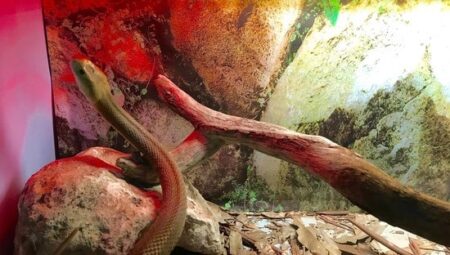
What Does the Coastal Taipan Look Like?
The coastal taipan looks quite similar to its central Australian relative, the inland taipan. It has the same round eyes and slim, brown body which gets darker in winter.
It has a narrow head, though when threatened it can spread its jaws out to make its head appear more spade-shaped. The coastal taipan regularly reaches 6 feet in length. In contrast with the inland taipan, the coastal taipan’s head is usually lighter in color than the rest of its body.
Is the Coastal Taipan Aggressive?
The coastal taipan, though its venom is not quite as potent as the other snakes on this list, is often regarded as the world’s most dangerous snake due to its propensity to bite.
Though it will not seek out confrontation with humans, if threatened, the coastal taipan will not hesitate to strike and envenomate. Dry bites are rare.
Caspian Cobra
The Caspian cobra is a close relative of the forest cobra, in the genus Naja, though it does not inhabit the same area of the world. It frequents several Central Asian countries to the southeast of the Caspian Sea.
Its venom is the most potent of all cobra species, including the forest cobra. However, it typically injects much less venom per bite. A bite from a Caspian cobra contains both neurotoxins and cytotoxins, which cause mass cell death and tissue damage.
Untreated, it’s fatal over 70% of the time. Antivenin for cobra bites tends not to be particularly effective on Caspian cobra bites.
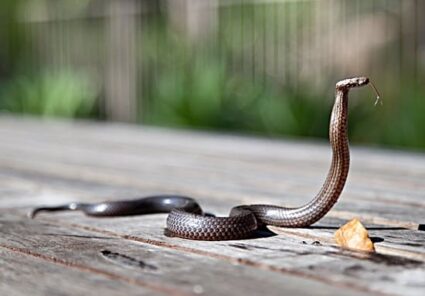
What Does the Caspian Cobra Look Like?
The Caspian cobra is a heavy-bodied snake of medium length. On average it reaches around 3.5 feet. However, some have reached 5 feet. Its coloration ranges from yellowish-tan to pale brown along its back.
Juveniles have thick, black bands that are most prominent on their undersides. These tend to fade in adulthood. Like all Cobras, Caspian cobras can expand their ribs to form a hood.
Is the Caspian Cobra Aggressive?
The Caspian cobra will not actively seek out people. However, even juveniles of the species react defensively to human presence.
It will try to escape if the threat is far enough away. However, when cornered, it will spread its hood and hiss before striking repeatedly.
Black Mamba
The black mamba is territorial and the fastest-moving snake, able to reach speeds of up to 10mph. Native to Sub-Saharan Africa, its bite is deadly.
A single bite from a black mamba could be strong enough to kill over 25 people. However, it can bite up to 12 times in a matter of seconds.
The venom contains neurotoxins and cardiotoxins (which damage the heart), and it is arguably the most fast-acting venom of all snakes.
Within 30 minutes of being bitten, victims can display breathing problems, as well as heart and brain abnormalities. Antivenin must be administered immediately as the rate of death without treatment is 100%.
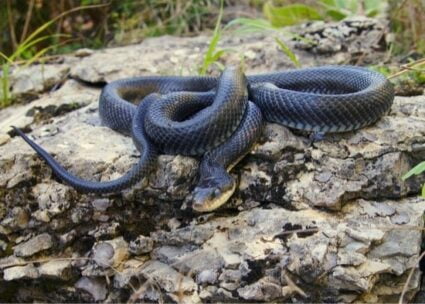
What Does the Black Mamba Look Like?
Contrary to its name, the black mamba is not black in color. Its skin ranges from light gray to olive green. The inside of its mouth is an inky black, from which it gets its name.
It has round pupils, smooth scales, and a slim body. One of the largest venomous snakes in the world, the black mamba can reach up to 14 feet in length, though 7-10 feet is more common. Its head is oval in shape, and is usually wider than its body.
Is the Black Mamba Aggressive?
The black mamba is very territorial, especially during the breeding season. It dislikes the presence of humans. In defense, it rears up, spreads excess neck skin to form a small hood, and gapes open-mouthed as a warning.
The slightest provocation by the perceived threat, including any small movement, can provoke an attack. Because of its body length, it can strike from far away, and will bite several times in quick succession.
Russell’s Viper
The first member of the viper family to make the list, the Russell’s viper belongs to India. It has a reputation for causing the most snake bite incidents in India and has highly toxic venom. It also, reportedly, has the loudest hiss in the snake world.
Russell’s viper has the venom that’s strong enough to kill over 20 people with a single bite. It is responsible for thousands of deaths each year. Its venom causes necrosis (death) of muscle tissue, kidney failure, internal bleeding and blistering. The venom is somewhat slow-acting as death can occur as late as 2 weeks after the bite.
Even if you survive, a bite from a Russell’s viper causes severe pain lasting for several weeks. It can also result in long-term complications, such as kidney and glandular problems.
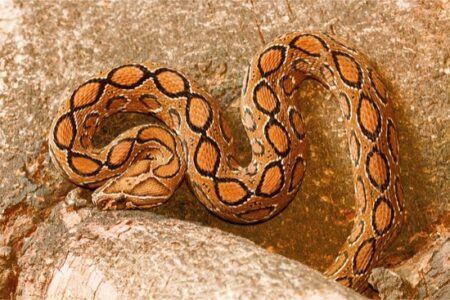
What Does the Russell’s Viper Look Like?
Russell’s vipers have stout bodies that are covered in rough, keeled scales. Coloration is usually yellow to tan, with many dark brown spots outlined in black along their bodies.
Their bodies are slightly more slender than a typical viper’s, and they do not usually exceed 4-5 feet in length. Their head shape is triangular and much wider than their neck, with slit-like pupils.
Is the Russell’s Viper Aggressive?
The Russell’s viper prefers to avoid human contact. When approached, it will try to escape. However, it moves quite slowly. Being stepped on or otherwise directly threatened can provoke a swift attack.
According to the Southeast Asian Journal of Tropical Medicine and Public Health, only about 8% of bites are dry.
King Cobra
The king cobra is the best-known cobra. Interestingly, it doesn’t belong to the genus Naja, which is the family of all the other cobras. It belongs to the genus Ophiophagus, meaning snake-eating.
The king cobra’s diet is primarily made up of eating other snakes, including venomous species. Native to Southeast Asia, it is the longest venomous snake in the world.
The venom of the king cobra, drop-for-drop, is the least potent on this list. However, as the snake is so large, it can inject up to 1000mg per bite.
A single bite could kill 11 people. Its venom is mostly made up of neurotoxins, affecting the central nervous system. Bites can result in blurred vision, dizziness, paralysis, and even coma.
Dry bites from king cobras have been reported. Of untreated bites that result in envenomation, around 50-60% will result in death.
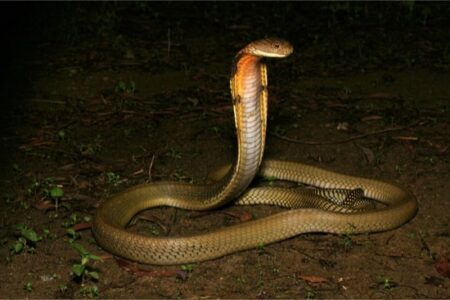
What Does the King Cobra Look Like?
Juvenile king cobras are a distinctive black in color with thin white or yellow crossbands along their bodies. As they get older, the king cobra’s main color fades to brown and markings become less distinctive.
Adult king cobras can reach up to 19 feet long, but the average is 10-13 feet. Like all Cobras, it can expand its ribs to form a menacing hood.
Is the King Cobra Aggressive?
King cobra bites are somewhat rare because they are non-confrontational. The king cobra prefers to escape humans than bite.
However, they will stand their ground when provoked and are not afraid to attack. Feign-strikes and dry bites come first, followed by true bites.
Indian Cobra
The Indian cobra is, of course, native to India. It’s one of the “big four” species of India, responsible for thousands of snake bite deaths each year. Found in abundance throughout the country from the north to south, it inhabits a diverse range of habitats, from forests to urban areas.
A bite from an Indian cobra is not the most toxic, but can still be potent enough to kill 10 people. Their venom is neurotoxic and cardiotoxic, and fast-acting. It inhibits the nerves, resulting in paralysis. If the bite is serious, it can cause respiratory failure and cardiac arrest. Antivenin is effective, but untreated bites lead to death 10-30% of the time.
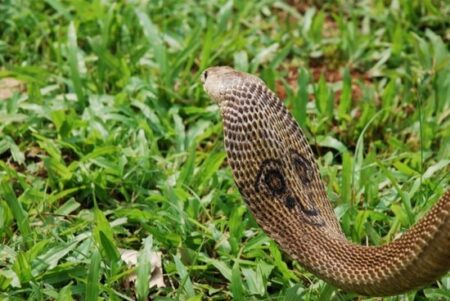
What Does the Indian Cobra Look Like?
The Indian cobra has a large hood that has 2 large black spots, one on each side of the neck. These act as “false eyes,” to scare away predators.
The back of the hood usually has a dark marking in the shape of a pair of spectacles. The Indian cobra’s colors can range from cream to dark brown, and they can reach up to 5 feet in length.
Is the Indian Cobra Aggressive?
According to the University of Adelaide’s clinical toxicology resources, the Indian cobra has a placid disposition. It will usually try to escape when a predator approaches as the first course of action.
If it is cornered, the Indian cobra will display its impressive hood while hissing and rearing up. It will only strike as a last resort, but when it does, it can bite repeatedly.
Cape Cobra
The cape cobra is found at the southernmost tip of Africa, in the countries of South Africa, Namibia, and Botswana. It is regarded as one of the most dangerous cobras in Africa because it’s found in residential areas.
A bite from the cape cobra may be toxic enough to kill at least 8 people. The venom is neurotoxic which targets the heart, nervous system, and respiratory system.
Symptom management is sufficient to help victims through the attack. Antivenin may be necessary if the victim has received a lot of venom. If left untreated, death from lung paralysis can occur up to 12 hours after the bite.
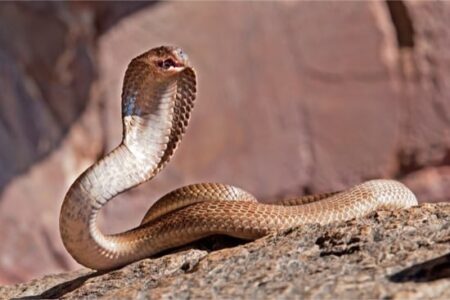
What Does the Cape Cobra Look Like?
The cape cobra is also called the “yellow cobra” or “copper cobra” because of its striking coloration which can appear yellow, gold or brown.
Some variants are speckled with dark spots or blotches. Young cape cobras have much darker throats than adults. Like all Cobras, they can expand their ribs to form a hood, as a warning to predators.
Is the Cape Cobra Aggressive?
Rather than fleeing from danger, the cape cobra tends to stand its ground. It positions the front half of its body upright, hisses and displays its hood. It is not averse to striking and will do so in response to any sudden movements.
Which Snake Causes the Most Deaths?
Just because a snake has a deadly bite does not necessarily mean that it poses the greatest threat. Many of the above species are responsible for very few human deaths.
This is due to their reclusiveness, reluctance to bite, and the abundant availability of antivenin. So, which snakes are responsible for the most human deaths in each continent?
North America
Fatal snake bites in North America are rare. In the U.S., though there are up to eight thousand snake bite incidents per year, only 5 result in death. North America’s venomous snakes are not deadly enough to have made the top 10 list, and most of the continent’s citizens have easy access to hospitals and antivenin treatment.
North America is home to several species of pit viper, including rattlesnakes, and also one elapid (the coral snake). Although the coral snakes are the most venomous, bites are extremely rare.
Deaths are caused by Eastern and Western diamondback rattlesnakes. These are the largest and most toxic rattlesnakes on the continent.
South America
South America is home to more species of dangerous snake due to its tropical climate. Out of these, the two responsible for the most human deaths are pit vipers: Bothrops atrox and Bothrops asper.
Though they are different species, they are both commonly nicknamed “Fer-de-Lance” meaning spearhead. The venom of both types of Fer-de-Lance is fast-acting. They both inhabit populous areas and can be highly aggressive when approached.
Africa
Africa is home to the black mamba. A bite from a black mamba almost always results in death, due to its potent and fast-acting venom.
Antivenin is available, but it must be administered quickly for the victim to survive. It’s thought that only around 2% of snake bite victims in sub-Saharan Africa receive antivenin, due to its low availability. The other dangerous snakes in Africa include:
- West African Carpet Viper. Some sources claim that this snake is responsible for the most deaths in Africa due to its constant contact with humans. It likes to live and hunt in farmlands.
- Puff Adder. This is a deadly viper found throughout most of central and southern Africa. It is aggressive and inhabits populated areas.
Asia
Each year in Asia, up to a million people suffer a venomous snake bite. Over 40,000 of these result in death. This makes up almost half of the worldwide annual death toll from snake bites.
The snakes that are responsible for causing the most incidents are referred to as the “Big Four.” They are:
- The Common Krait, an elapid with very potent venom, found in a variety of habitats from Pakistan to West Bengal in India. Though it is reluctant to bite, it is also unwilling to let go once it has bitten, allowing it to inject a large amount of venom.
- Russell’s Viper, the seventh most lethal snake in the world, is responsible for up to half of all Asian snakebite fatalities. Bites usually happen when stepping on the snake by mistake.
- The Saw Scaled Viper, a small yet lethal snake with an aggressive demeanor, kills 5,000 Indians per year. It’s known for the characteristic sizzling noise it makes from rubbing its scales together.
- The Indian Cobra, the world’s ninth most venomous snake, bites over 100,000 people per year in Asia. Between 5 and 20% of bites are fatal.
Australia
Australia is home to many species of highly venomous and dangerous snakes, including the most venomous snake in the world, the inland taipan.
However, inland taipan bites are relatively uncommon. As they inhabit the deserted Australian outback, they very rarely encounter humans and are quite placid even when they do.
The crown for the most dangerous snake in Australia belongs to the eastern brown snake. This snake is thought to be responsible for 60% of all snake bite-related deaths in the country.
This is because they live in populated areas, such as farms and residential areas. Coming in at a close second is the coastal taipan, which is famed for its aggressive nature.
The highly venomous Belcher’s sea snake also inhabits the waters of Australia. However, due to its docile nature, bites are quite rare.
Europe
Out of all the continents on earth, Europe has the least venomous snakes. This is mostly because venomous snakes tend to live in warmer climates, and much of Europe is in the temperate zone. However, many European countries are home to a limited number of species of the viper family.
According to the Bulletin of the World Health Organization, deaths from snake bites in Europe are rare. There are less than 30 reported deaths per year across the whole continent. The most common perpetrators include:
- Asp Vipers, common in France and Italy.
- Sand Vipers, or nose-horned vipers, found in southeast Europe.
- Common Vipers found widely throughout most of Europe. They are the only venomous snake found in the United Kingdom.
- Lataste’s Vipers, or snub-nosed vipers, found in Portugal and Spain.
If you come across one of the world’s most deadly snakes, you should back away slowly. Give the snake a chance to escape as it will seek to avoid confrontation. If you do get bitten by a venomous snake, go straight to the hospital so that the appropriate antivenom can be administered.

